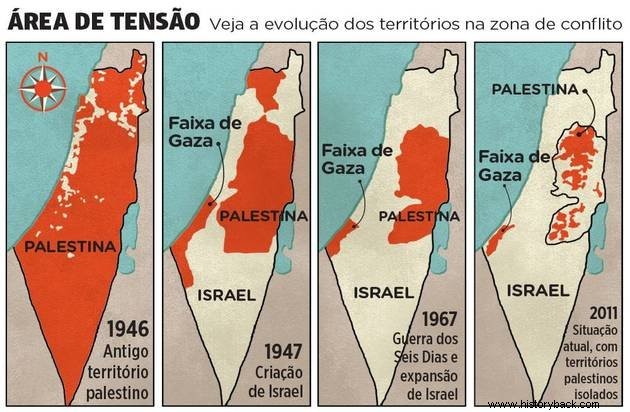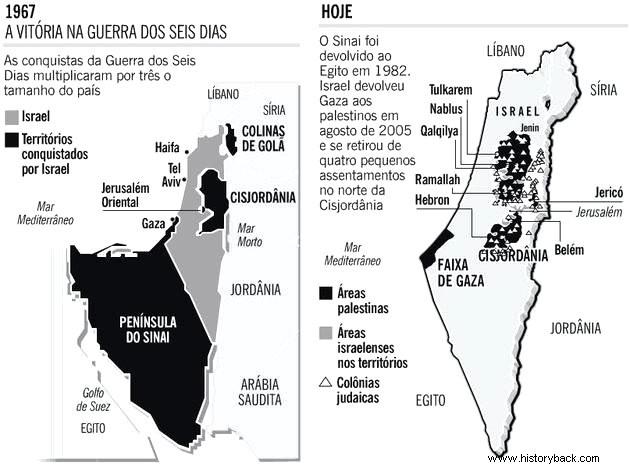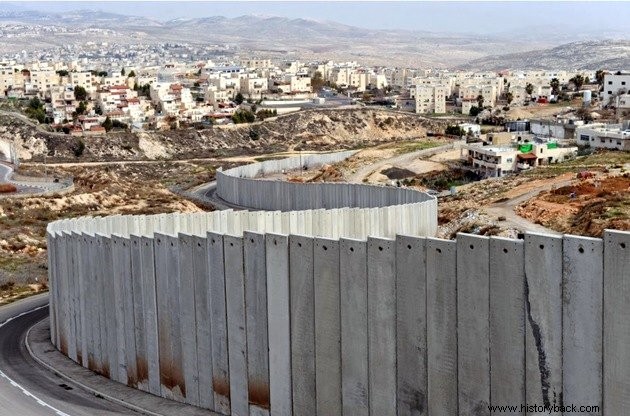The conflict between Israel and Palestine it is a dispute over ownership of Palestinian territory and is at the center of current political and diplomatic debates.
The dispute intensified at the end of the 20th century, starting in 1948 when the creation of the State of Israel was declared.
Origin of the Conflict between Israel and Palestine
Palestine is located between the Jordan River and the Mediterranean Sea in the Middle East and until the start of the First World War in 1914 it was under the rule of the Ottoman Empire.
With the dissolution of this empire, England began to administer the region in 1917. It is estimated that by the end of 1946, Palestine was inhabited by about 1.2 million Arabs and 608,000 Jews.
At the end of the conflict, the Jews started a series of migratory movements in an attempt to find a new home after the persecutions that took place in Europe. Thus, the area became dominated by Jews from the end of the Second World War.
For these people, the region is called "Holy Land" and "Promised Land" , but the concept of a sacred place is shared by Muslims and Christians alike.

Causes of the Conflict between Israel and Palestine
The causes for the conflict are remote and if we have to put a date, it would certainly be the expulsion of the Jews by the Romans in the year 70 AD, when the Jews had to move to North Africa and Europe.
In the 19th century, however, in the wave of nationalism that emerged in Europe, some Jews gathered around the Zionist ideas of the Hungarian Theodor Herzl (1860-1904). This advocated that the home for the Jews should be in "Zion" or the land of Israel, Palestine and, finally, the Jews would have a home like other peoples.
At the end of the Second World War (1945), the Zionist Jews began to press for the creation of the Jewish State.
During the conflict, 6 million Jews were exterminated in concentration camps under Adolf Hitler (1889-1945). Thus, with international support, mainly through US action, the region was divided in 1948-1949 into three parts:the State of Israel, the West Bank and the Gaza Strip.
The division, programmed by the UN (United Nations), provided for the transfer of 55% of the territory to the Jews and 44% would remain to the Palestinians.
The cities of Bethlehem and Jerusalem would be considered international territory because of their religious significance for Muslims, Jews and Christians. However, the Arab representatives did not accept the determinations.
See also:Jewish DiasporaFoundation of the State of Israel
On May 14, 1948, however, Israel was founded after the British had withdrawn. The next day, Egypt, Syria, Jordan and Iraq invade Israel and start the War of Independence, which was called Nakba or "catastrophe" by the Arabs.
The war ended in 1949 and resulted in the expulsion of 750,000 Palestinians who went on to live as refugees in a movement known as the "Exodus from Nakba" .
As a result of the expulsion of the Palestinians, Israel increased the territory by 50%. The extension of land was indicated by the UN and they occupy 78% of the area destined to Palestine.
The action was not questioned by the international community. The reaction only took place in 1956 after Israel disputed with Egypt control over the Suez Canal and won the right to explore it by order of the UN.
In 1959 the PLO (Palestine Liberation Organization) was founded, which was only recognized by the UN in 1974.
Six Day War (1967)

A new conflict, however, this time in 1967, yields victories for Israel. In the so-called Six Day War, Israel occupies the Gaza Strip, the Sinai Peninsula, the West Bank and the Golan Heights in Syria.
As a result, half a million Palestinians flee and the UN Security Council passes Resolution 242. It makes the acquisition of territories by force inadmissible and the right of all states in the region to peacefully coexist.
The Arabs try to regain the territory occupied in 1973, in the Yom Kippur War (Jewish holy day), which lasted from 6 to 26 October. However, it was not until 1979 that Israel returned the Sinai Peninsula to Egypt after signing a peace agreement.
See also:Six Day WarWhat does the Bible say?
The reasons for establishing the Jewish state in the region were based on biblical sources.
Jews consider the area between Africa and the Middle East, where Palestine is, the land promised by God to the prophet Abraham.
This corresponds to the territories currently occupied by the State of Israel, Palestine, the West Bank, West Jordan, southern Syria and southern Lebanon. The so-called biblical patriarchs received it after the Exodus.
This is the claim of the Zionist Jews who demand full occupation of the territory. Before the post-war occupation, 4% of the population of Palestine were Jews.
The right from the biblical promise is rejected by the Arabs and they say that Abraham's son Ishmael is his ancestor. In this way, God's promise would include them as well. Furthermore, the Palestinians' claim is based on the right to occupation, which took place for 13 centuries.
The Occupation of Palestine
The region was occupied 2,000 years BC. by Amorite, Canaanite and Phoenician peoples, being called the Land of Canaan. The arrival of Hebrews of Semitic origin took place between 1,800 and 1,500 BC.
Successive invasions marked the region. In 538 BC, the commander of Persia, Cyrus the Great, occupied the region, later retaken in an invasion led by Alexander the Great in 331 BC. The Roman invasion under the leadership of Pompey took place in 64 BC
Roman rule lasted until 634 AD. when the Arab conquest marks the beginning of 13 centuries of Muslim permanence in Palestine. Under Arab rule, Palestine was the target of several Crusades between 1099 and 1291 and in 1517 the Ottoman occupation began, which lasted until 1917.
After onslaughts by France, under the command of Napoleon Bonaparte (1769-1821), Palestine passes to the domain of Egypt and the Arab revolt begins in 1834.
It was only in 1840 that the Treaty of London ended Egyptian rule in the region and in 1880 the manifestations of Arab autonomy began.
In 1917, Palestine is submitted to the British mandate. The British command lasts until February 1947, when England renounces the mandate over Palestine and hands over most of the war equipment to the Zionist groups.
See also:HebrewsConflict between Israel and Palestine in the 21st century

Far from over, the conflict still rages on and thousands of Arabs are still in refugee camps. The Palestinian National Authority claims UN approval of Palestinian state autonomy.
It also demands the withdrawal of Israeli settlements from the West Bank, a situation that has been condemned by the International Court in The Hague, but remains.
The Palestinians also demand that the future Palestinian State have the pre-1967 structure as its boundary marks. In addition, they want the return of 10 million refugees to the region currently occupied by Israel.
The State of Israel claims the entirety of Jerusalem, a claim that was not accepted by the Hague Convention.
Wall of Israel
In the field, the military and economic advantage is Israeli. In 2002, the Israeli government, under the command of Ariel Sharon (1928-2014) began the construction of a wall in the West Bank.
The barrier, built on the grounds of protecting Israel from Palestinian attacks, separates local communities from agricultural areas. Despite international criticism, the project was maintained.
New attacks were initiated in 2014 by Israel against the West Bank. It was the most violent offensive since 2005, when a ceasefire took place after the promise of the withdrawal of Jewish colonies from Palestinian territories.
In 53 days of conflict, in the summer of 2014, 2,200 Palestinians were killed. Of them, 1,500 were civilians and 538 were minors, according to data from OCHA (United Nations Office for the Coordination of Humanitarian Affairs in the Occupied Palestinian Territories). On the Israeli side, the fighting resulted in 71 deaths, six of them civilians.
Read further :
- Middle East
- War in Syria
- Crusades
